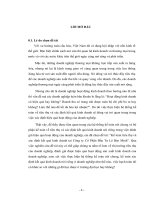Min trace elements
Bạn đang xem bản rút gọn của tài liệu. Xem và tải ngay bản đầy đủ của tài liệu tại đây (171.64 KB, 28 trang )
Minerals and trace
elements
Dr K N Prasad MD., DNB.
Community Medicine
Seven Food Substances
Dietary Fibre
Water
Minerals
Food Substances
Proteins
Vitamins
Fats
Carbohydrates
Minerals
50 chemical elements are identified
Important for Growth, Development , regulation
of vital functions
Major : calcium, Phosphorous, Sodium,
Potassium, Magnesium
Minor: Required less than a few milligram per
day. Ex. Iron, Iodine, Fluorine, Zinc, Copper,
Cobalt, Chromium, Manganese, Molybdenum,
Selenium, Nickel, Tin, Silicon, Vanadium
Trace elements
A naturally occurring, homogeneous, inorganic
substance required in humans in amounts less
than 100 mg/day
Bioavailability of minerals are low in vegetarian
diet.
Excess amounts are injurious to health
Iron
Adult human body contains 3-4 Gm
60-70% is present in Blood and rest in storage form.
Each Gm of Hb contains 3.34mg of Iron.
Requirement :
1 mg per day for Male
2.5 mg for Females
3.5 mg for Females in Physiological stress
conditions
Functions of iron
Iron is a part of all cells and has many different
functions
Hb Carries of oxygen to the tissues
Brain development along with Folic acid
Myoglobin Facilitates oxygen use and storage in
muscles
An integral part of enzyme reactions in various tissues
( Cyotchromes, Catalases, etc)
Regulation of Body temperature
Catecholamine metabolism
Susceptibility to infection
Sources of iron
Haem Iron:
Liver, meat, poultry, Fish
Non Haem Iron:
Cereals, GLV, Legumes,, Nuts, Oil seeds, Dried
Fruits, Jaggery
Factors interfere in absorption are enzymes in
the food – Phytates, Oxalates, Phosphates,
Dietary fibres
Ascorbic acid is the most potent enhancer iron
Public Health problem
Categorized as one of the top ten most serious health
problems in the modern world (WHO)
As many as 4-5 billion people (66-80% of
population) may be iron deficient
2 billion people (>30% of population) are anemic
Iron deficiency in young children is the rule rather
than the exception (from 45 to 70 percent prevalence
Anemia is a fact of life for almost 500 million of
women of childbearing age(~40% of 15 to 40 y old
females in developing world)
More than 1,000 severely anemic young women die
every week in the perinatal period because of
inadequate iron status
Iron loss
In adults – 1 mg per day
Menstruating women – 2 mg per day
Hemorrhages are common causes
IUCD may loss result in blood loss
Storage
Stored in Liver, Spleen, Bone marrow,
Kidneys
Iron Deficiency
Occurs in 3 stages:
First Stage: Decreased storage without any other
detectable abnormalities
Second Stage: stores are exhausted, serum
Ferritin level decreases.
Third Stage: Decrease in Hemoglobin percentage
Functional disturbances: decrease in resistance to
infection, increase morbidity & mortality,
decreased work performances, impaired cell
mediated immunity
Iron
Signs of iron deficiency anemia include:
Fatigue
Headache
Exertional dyspnoea
Cardiovascular stress
Poor tolerance to heavy blood loss
Evaluation of iron status
1. Hemoglobin Concentration: relative index
of iron deficiency. ( early Anemia if Hb is
10-11g% & marked anemia Hb is < 10g
%).
2. Serum Iron concentration: useful index
( Normal 0.8 to 1.8mg /L)
3. Serum Ferritin level: Gold standard &
sensitive tool for evaluation and reflects the
size of the iron status ( < 10Micrgms/L)
Correction of Iron Deficiency
Oral iron supplements
100 200 mg elemental iron daily
Higher doses are of no benefit
Ferrous sulphate 65mg/tab
Pregnant women- 100mg/tablet (+ folic
acid)
Iodine
Essential Micronutrient
Body normally has 20-30 mg of iodine and more than
75% is in the thyroid gland,
rest is in the mammary gland, gastric mucosa, and blood
it’s only function is related to thyroid Hormone
Required for synthesis of thyroid hormone
Thyroxin (T4) – 4 atoms of iodine per molecule
Triiodothyronine (T3) – 3 atoms of iodine per molecule
Requirement per day is 150 micrograms
Iodine
Food Sources – 90% intake
Foods of marine origin (seaweed), processed foods,
iodized salt
Fresh Water – small & Variable
Small amounts in Milk, meat, Vegetables, Cereals
etc.
Goitrogens occurring naturally in foods can
cause goiter by blocking absorption or utilization of
iodine (cabbage, turnips, peanuts, soybeans)
Iodine - Absorption and Excretion
Iodine is absorbed in the form of iodide
occurs both as free and protein-bound iodine in
circulation
iodine is stored in the thyroid where it is used for
the synthesis of T3 and T4
hormone is degraded in target cells and in the
liver and the iodine is conserved if needed
excretion is primarily via urine
small amounts from bile are excreted in the feces
Iodine - deficiency
Goitre—enlargement of the thyroid gland
deficiency may be absolute—in areas of deficiency,
or relative—adolescence, pregnancy, lactation
goiters are more prevalent in women and with increased age
Iodine deficiency is the world’s most prevalent cause of brain
damage
Serious iodine deficiency during pregnancy may result in
stillbirths, abortions and cretinism
the less visible, more pervasive form of iron & iodine
deficiency that lowers intellectual performance at home and
school may have far greater global and economic impact
Public Health problem of Iodine
By the year 2000,
Global prevalence of iodine deficiency from 30% to <15%
Adding iodine to 2/3 of the world’s household salt
70 million newborns protected in some Degree
Every year, 50 million children are born without the
protection that iodine offers to the growing brain and body
About 18 million of those will suffer some significant
degree of mental impairment
Iodine deficiency remains the single greatest cause of
mental retardation
The one third of the world’s people without protection by
iodized salt are the most marginalized populations –
economically, culturally and geographically
Sustainability is another battle: salt iodization is slipping
back in several countries
Epidemiological assessment
Prevalence of Goitre
Prevalence of Cretinism
Urinary iodine excretion
Prevalence of Neurological hypothyroidism
Thyroid Function tests
Neonatal Hypothyroidism is a sensitive indicator of
environmental iodine deficiency
Serum T4 is more sensitive indicator among adults
Fluorine
It is found in combined forms
96% of fluorides in the body found in bone and teeth.
An essential for normal mineralisation of bones and
formation of dental enamel
Source:
Drinking water : Fluorine in the drinking water is
0.5 mg per ltr. Excess of fl > 3mg causes flourosis.
Foods: Sea fish, cheese, Tea
It is a two edged sword ( deficiency or excess)
Zinc
Adult body contains 1.4 to 2.3 gms of Zinc
Plasma level- 96Microgm per 100 ml ( adults), 89
Microgram per 100 ml (children)
Functions are
Active role in metabolism of glucose and proteins
Synthesis of insulin by pancreas
Immunity functions
Food sources :
meat, milk, fish
Plant sources have low bioavailability
Zinc
On of the ten biggest factors contributing to burden
of disease in developing countries
Zinc interventions could reduce child deaths
globally by 63%
South East Asia and Sub-Saharan Africa highest
risk of zinc deficiency:
Inadequate intake – 1/3 of the population
Stunting – 40% of pre-school children
Zinc used as a (part of) curative intervention for
severe malnutrition and diarrhoea









